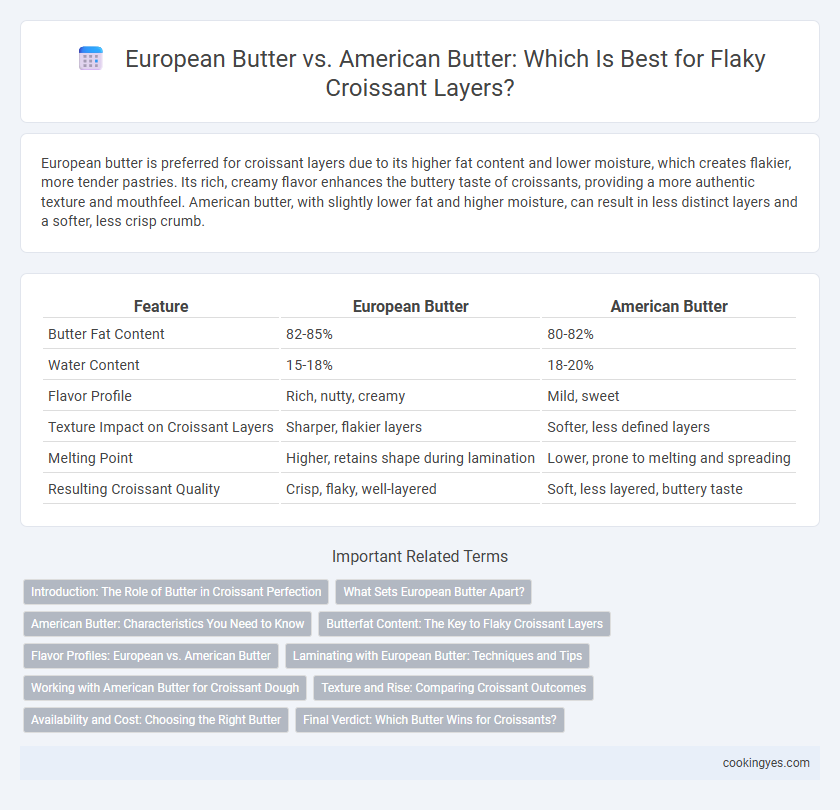European butter is preferred for croissant layers due to its higher fat content and lower moisture, which creates flakier, more tender pastries. Its rich, creamy flavor enhances the buttery taste of croissants, providing a more authentic texture and mouthfeel. American butter, with slightly lower fat and higher moisture, can result in less distinct layers and a softer, less crisp crumb.
Table of Comparison
| Feature | European Butter | American Butter |
|---|---|---|
| Butter Fat Content | 82-85% | 80-82% |
| Water Content | 15-18% | 18-20% |
| Flavor Profile | Rich, nutty, creamy | Mild, sweet |
| Texture Impact on Croissant Layers | Sharper, flakier layers | Softer, less defined layers |
| Melting Point | Higher, retains shape during lamination | Lower, prone to melting and spreading |
| Resulting Croissant Quality | Crisp, flaky, well-layered | Soft, less layered, buttery taste |
Introduction: The Role of Butter in Croissant Perfection
European butter, with its higher fat content of around 82-85%, enhances croissant layers by creating flakier and more tender pastries compared to American butter, which typically contains 80-82% fat. The water content and fat crystallization properties in European butter contribute to better lamination, resulting in distinct, airy layers essential for croissant perfection. Using high-fat European butter ensures optimal texture and flavor, crucial for achieving the traditional buttery richness and delicate structure in authentic croissants.
What Sets European Butter Apart?
European butter is distinguished by its higher fat content, typically around 82-85%, compared to American butter's 80%, resulting in richer, flakier croissant layers. Its lower water content and less salt preserve the dough's elasticity and enhance lamination, creating distinct, tender layers. Moreover, European butter's unique fermentation process imparts a deeper, creamier flavor that elevates the overall croissant experience.
American Butter: Characteristics You Need to Know
American butter typically contains higher water content, around 15-18%, compared to European butter's 82-85% butterfat, which affects the lamination process in croissant dough. This increased moisture can cause the dough to be less flaky and result in fewer distinct layers, but it also offers a softer texture and milder flavor profile. Bakers using American butter often adjust chilling and rolling times to optimize rollability and achieve desirable rise and flakiness in croissants.
Butterfat Content: The Key to Flaky Croissant Layers
European butter typically contains 82-85% butterfat, significantly higher than American butter's average of 80%. This higher butterfat content in European butter creates richer, flakier layers in croissants by melting at a slower rate during baking. The increased fat facilitates better lamination, enhancing the croissant's characteristic crispness and delicate texture.
Flavor Profiles: European vs. American Butter
European butter, known for its higher fat content (82-85%) and lower water percentage, delivers a richer, creamier flavor that enhances croissant layers with a deep, buttery taste and a silky texture. American butter contains slightly less fat (around 80%) and more water, producing a milder, less intense flavor that can result in croissants with a lighter, less pronounced buttery profile. The cultured fermentation process often used in European butter adds subtle tangy notes, intensifying the flavor contrast and complexity in croissant layers compared to the typically sweeter and more neutral American butter.
Laminating with European Butter: Techniques and Tips
European butter contains higher fat content, typically around 82-85%, compared to American butter's 80%, making it ideal for laminating croissant dough due to its superior plasticity and lower moisture content. Laminating with European butter allows for thinner, more consistent layers, resulting in a flakier, more tender croissant texture. Techniques such as keeping the butter cold but pliable, using a butter block shaped for even folding, and precise rolling ensure optimal layer separation and crispness in the final product.
Working with American Butter for Croissant Dough
American butter's higher water content and lower fat percentage compared to European butter impacts croissant dough's lamination, requiring precise temperature control to prevent dough sogginess and maintain distinct buttery layers. Bakers often chill American butter thoroughly and incorporate it in thinner sheets during lamination to achieve optimal flakiness and rise. Adjusting dough hydration levels compensates for moisture variance, ensuring balanced elasticity and layering characteristic of classic croissants.
Texture and Rise: Comparing Croissant Outcomes
European butter, with its higher fat content of around 82-85%, creates flakier, more tender croissant layers due to better lamination and moisture retention, enhancing rise and texture. American butter generally contains about 80% fat and higher water content, producing slightly less crisp layers and a denser crumb. The lower melting point of European butter helps maintain distinct, airy layers during baking, resulting in superior rise and an iconic flaky texture.
Availability and Cost: Choosing the Right Butter
European butter, known for its higher fat content and lower water percentage, creates flakier, richer croissant layers but typically comes with a higher price tag and may be less readily available in American markets. American butter, while more accessible and cost-effective, often contains more water and less fat, which can result in less tender and buttery croissant layers. Bakers must weigh the cost-efficiency and availability of American butter against the superior quality and flavor benefits of European butter to achieve the desired croissant texture.
Final Verdict: Which Butter Wins for Croissants?
European butter, with its higher fat content of around 82-85% compared to American butter's average 80%, produces flakier, richer croissant layers due to increased moisture loss during baking. The higher fat and lower water content in European butter such as French or Irish variants enhance lamination, creating distinct, crispy layers with superior flavor and texture. For the ultimate croissant, European butter consistently outperforms American butter in achieving delicate, buttery, and tender layers prized in traditional French pastry.
European butter vs American butter for croissant layers Infographic

 cookingyes.com
cookingyes.com